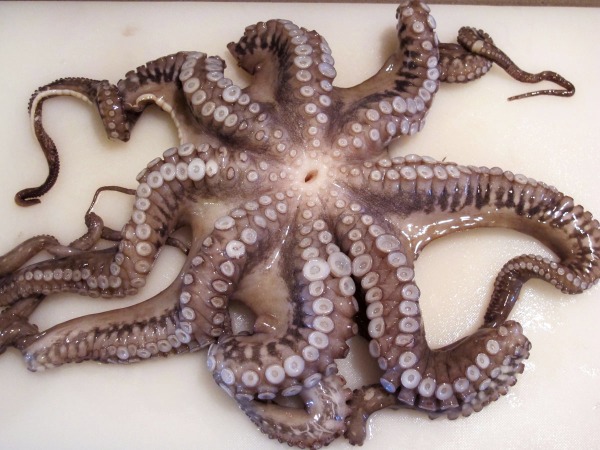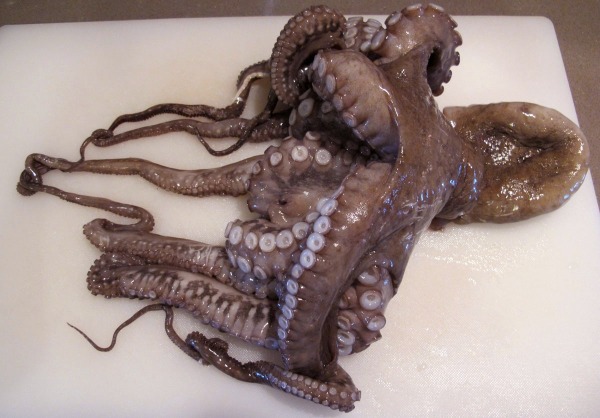So you can break down a chicken, truss a duck and french a rack of lamb? Have you tried cooking an octopus?
There are some dishes which are so failure-prone that a vibrant mythology is built around how to avoid the usual pitfalls. Tenderizing octopus certainly falls into that camp. A quick Google search on the subject quickly reveals that the best way to cook a tender octopus is to vigorously beat it on some Grecian rocks. Or to cook it with wine corks in the pot. Or to add some vinegar. Or maybe the secret is to rub the octopus with grated daikon radish. Actually, scratch all that, the real key to success is to slowly dip the octopus a few seconds at a time into hot water until it acclimates to the boiling temperatures. All of these methods have their proponents, who will wholeheartedly assure you that it will work because after all, that is how their grandfather did it, and his father and his before that.
Since I lack heritage knowledge in octopus cookery, I turned to the next best option: esteemed chef and food scientist Harold McGee. In this article, he admits that his own results with octopus have been inconsistent—sometimes chewy, sometimes fibrous—and proceeds to test all of the usual methods for tenderizing octopus. The result? None of them seemed to be foolproof.
The issue is that without a skeleton, an octopus needs tough connective tissues to support itself, particularly in its arms. If the connective tissue is heated, it begins to dissolve into gelatin at 130° F, and dissolves most rapidly at 190-200° F. Hence most recipes ask you to cook the octopus at a bare simmer or low boil.
But cooking the octopus in a pot of water means that you dilute the flavor of the octopus and all the gelatin and juices that will be exuded. So, McGee suggests another method: slow roasting the octopus in the oven.
Back to the octopus itself. I had a fine 3-lb specimen, frozen with its arms symmetrically splayed around its head. (By the way, scientifically speaking, cephalopod arms, which have suckers along most of their length, are distinct from cephalopod tentacles, which have suckers only near the tips. Therefore, an octopus has eight arms and no tentacles, while a squid has eight arms and two tentacles.) After an overnight rest in the refrigerator, the octopus was relaxed and ready to be cooked.
I’m no lily in the kitchen, but looking at the octopus in its entirety, I suddenly felt a tinge of nervousness. I flipped the octopus over, and a floppy sucker stuck to my hand with a slight squelch. Chasing away the thought that the octopus was fighting back, I lay the octopus on its side and cut the head from the arms. Almost all frozen octopuses are cleaned beforehand, but if you are lucky enough to have a fresh octopus, you must turn the head sac inside out and remove the guts and ink sac.
Next, take a look at the top of the arms, at the center where they all meet. There is a small hole that contains the octopus’ beak, or mouth. Poke a finger into the hole and push out the beak until it comes out of the bottom side.
At this point, you’re ready to separate the arms into eight pieces. Or, you can leave them together, but I found it easier to maneuver the smaller pieces. I added the octopus to a heavy bottomed pot, along with a cup of water, just enough to keep it barely wet. After cooking the octopus on low heat for about 7 minutes, the arms began to curl and release their juices. Then I transferred everything, including the liquid, into a glass baking dish covered with foil, and put it into a preheated oven at 200° F.
Three hours later, it was dramatic though not surprising how much the octopus had shrunk. In the pan, I now had over a pint of thickened, flavorful octopus gelatin and pieces of tender, plum-hued octopus.
From here, you can do a number of things with the octopus: grill it, add it to pasta, or eat it simply with lemon and olive oil. Stay tuned to find out what happened to this particular octopus!




One thought on “Cork, Rocks and Vinegar: How (Not) to Cook an Octopus”